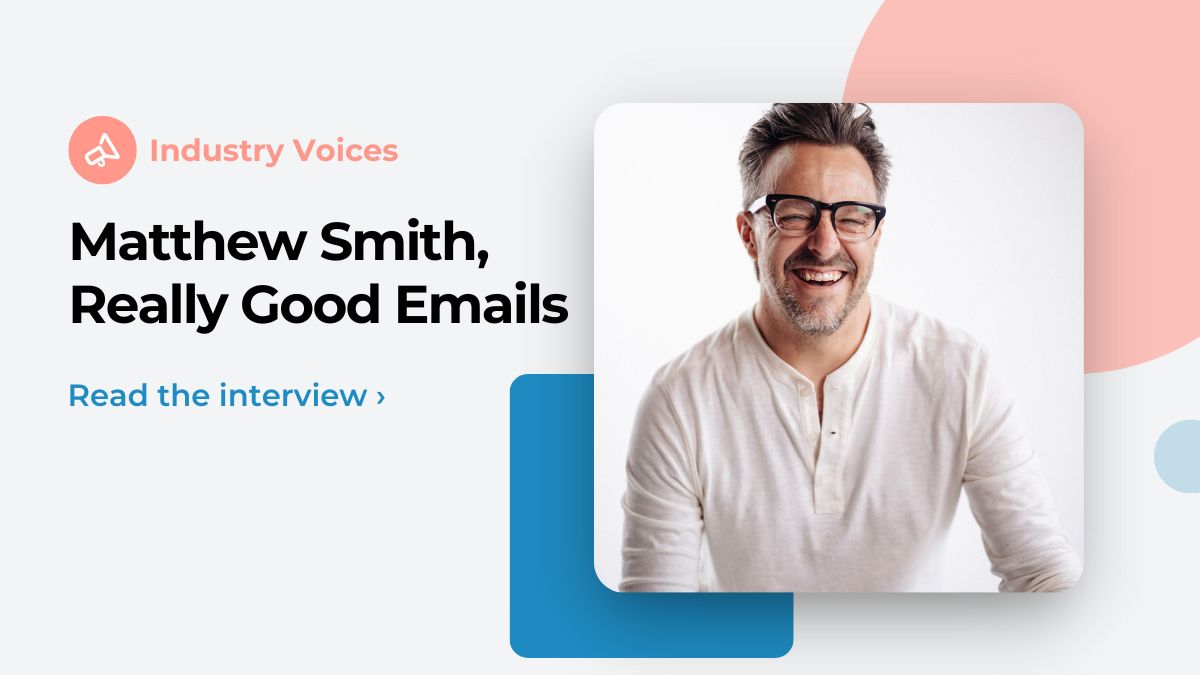
Matthew Smith, Really Good Emails: On AI, Building Relationships and The One Thing You Should Be Doing with Your Emails
Matthew Smith, the co-founder and CEO of Really Good Emails, knows what it takes to send emails that resonate, connect and, eventually, convert. In this #ZeroBounceInterview, Matthew invites us to look at the bigger picture of email marketing and see that community is at the core.
Read the interview or scroll down to watch the video interview below.
Matthew has a design background which is part of what drives his interest in curating the very best emails in the world. Really Good Emails – or RGE – spreads inspiration through their website and their weekly newsletter is pretty hot, too.
Matthew is known for saying, “Ask me anything about anything.” What could be better!
Read on to find out:
- What Matthew Smith thinks about the mounting AI revolution
- The Importance of relationships for email marketers
- How to use communication, segmentation and design to get better engagement and click-throughs.
Everybody in this community of email folks or email geeks is thinking about community in the face of AI. We know AI is coming at us. What do you think is coming?
It’s an interesting time.
I’ve been reflecting on other moments in history where there was this kind of cataclysmic shift. I don’t know that it can be mapped back in the same way because we didn’t have the speed of things. I’ve been thinking about the advent of photography and how photography, especially once it became more accessible, really changed the way that people thought about painting and capturing someone’s image or likeness in a painting.
Obviously, this is much different. It’s faster. It’s very disorienting. I think a lot of us are diving right in, and maybe our nervous systems are a little bit more amped up. And some of us think: “Okay, I’ve got to figure this out. This is exciting. This is nerve-wracking and terrifying. But here we go.”
And then I noticed other people from the sidelines sort of saying: “No, thanks. I’m not interested. I’m staying back. This feels like hype.”
But look at the amount of change that we’ve seen. It’s been just four months since the strong release of ChatGPT, and look at what OpenAI is doing and Bing, Google and then Meta. Apple is on its way and others are, too. So it’s very exciting, but it’s also really challenging.
I love thinking about history. I love psychology and do a lot of thinking about people. We’re inundated with so much information and misinformation, muddy information, or in some cases, even disinformation. Things are specifically targeted to be wrong information. We are looking for more reality, more checking in with each other, and more connection to balance out that experience.
Have you always been interested in “community”?
All throughout my life, I’ve been very community-oriented.
I had a difficult childhood. That set me up for the way that it worked for me. I began to strategize, connecting with people as a way to soothe that part of my nervous system. And then, I found that I could bring many people together. We could have a group. We could create friends, and sets. And you can see it in Really Good Emails.
We loved to be this gatherer of people celebrating the industry and creating a community of people. In our events, we wanted to all get together and appreciate and celebrate each other.
Really Good Emails wanted to be the Yoda in the story, not the Skywalker family. We wanted our audience to be the Skywalkers, the Leias, the Lukes, the Reys, and really just push on the idea that they get to have their story. They get to celebrate – and we create these communities.
I tend to think that the email geeks community is really unique. It has a lot to do with how hard the problem is. It’s a really steep learning curve to learn how to do email really well. And it’s not just the technology, which is very difficult and convoluted. We’re still working in freaking tables and things like that, but also the number of different platforms, how you use those platforms, personalization, deliverability – there’s so much and it can be really complicated.
So we lean on each other. We want to learn from each other, you know?
The closest thing I’ve experienced to that was the web right at the beginning. Web 1.0 was the most static website you can imagine. They were HTML only, everything was in line. But once we started separating out the JavaScript and CSS layers, folks like myself started working on Web 2.0, in the early 2000 and late nineties. That was an exciting time. You could view source, just right-click to see everything. There was this real camaraderie.
What are you doing? How are you solving this problem? How do we go after this? We would learn from each other at events and using the forums. There were PHP, phpBB forums everywhere, and we were learning those things. And, man, it was an exciting time!
Email geeks definitely feel like a community, don’t you think?
Email geeks have the quality of real camaraderie, a sense of belonging. Places like Twitter, TikTok, etc., still have their momentum. But I think more and more people will end up seeking out alternative groups that are much more niche. The challenging side of that would be cliquey and maybe you’ll get groupthink in some of these little communities. But on the positive side, you find a more honest, earnest, authentic connection.
At the end of the day, I’m not really bullish on emails being some kind of catchall solvent for all of humanity’s problems. I’m more interested in relationships and I’m interested in human wellness and growth. But I do think that email is an interesting tool to actually work on that material, even between consumer and brand.
So the idea I’ve often stated is that email is relationship delivered. You have this opportunity to create a connection between you and your audience. If you have an audience, you treat that audience respectfully. This means you listen to them empathetically. A lot of people either think of empathy and make it something very soft and mushy. Or they reject empathy. They think: “This is bull. It doesn’t mean anything.”
But there’s this middle way that people forget, and it’s just being quite human. It’s asking questions and trying to understand. Being an active listener. What is your audience experiencing?
If you understand that well and thoughtfully, it’s actually very, very good for business. It can accelerate what you’re doing because you’re meeting needs with more articulation, and more texture. Email is an interesting space for us to be able to do that.
That’s how I think about all these things.
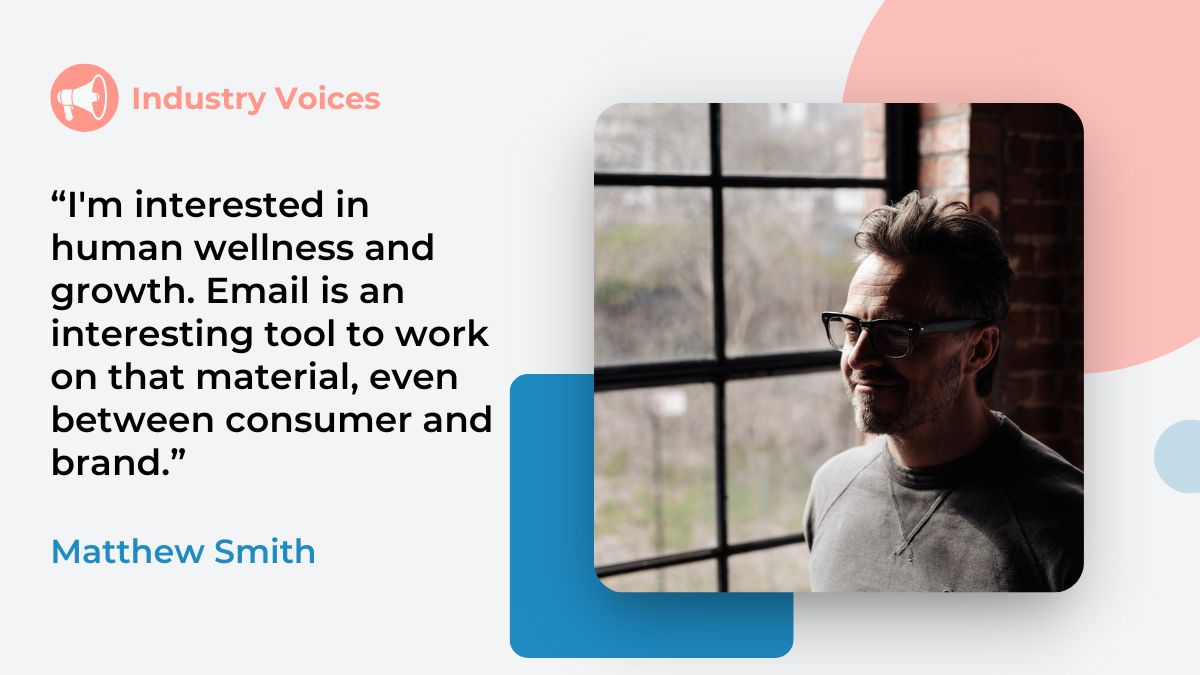
I do see people seeking out more connection and realness – a real human-to-human interaction. And there’s a way to do that with email. I know we can.
Yeah, that’s right.
I strongly recommend reading Yuval Noah Harari. Harari has some fantastic writing about the origins of humans. As we move into the biological and technological revolutions, and now this AI revolution, we ask: how does it affect humanity? Where are we going? What are some speculative, interesting and likely outcomes? I’ve read Sapiens and 21 Lessons for the 21st Century and in both, he talks about humanity needing to really grow to be as adaptive as possible.
The people who will survive this time – and potentially thrive – will be those who can adapt.
And sadly, because of the way our society is structured, many people have not developed that technique. Anything we can do to aid our fellow human beings in growing and adaptation will be something that we can do to maintain that community.
I’m very interested in the idea that there are groups that can do this. I don’t think this is me, I’m not ready to start a company, but I have thought that it’s within the purview of a company like OpenAI to develop tooling or direction for the AI to support those who might be less adaptive. Or maybe those within certain economic spectrums can get greater tools to be able to be more effective at their jobs, instead of losing their jobs.
Now, that said, I was talking to a friend last week who runs a large code school and he’s having to lay off something like 60 people in the next month because AI can do their jobs so much more effectively. They’re developers. And so it’s not that you can just replace developers in total, but now one senior developer can do what ten could do previously, right? So, there will be huge shifts.
The podcasts I’ve listened to have suggested that the kind of tectonic quality of these shifts will be such that it could really cause some real distress. So as somebody who cares about community, I’m really concerned about that.
And then I’m looking out for ways to support my community and disadvantaged and marginalized communities to be more prepared. So if anybody knows about some of the things like that going on, I’m really curious and I would love a DM. I’m @whale on Twitter and they’re wide open. I love to have these conversations.
I want to go back to something I’ve heard you say a couple of times. That email is relationship. How did you come upon that realization?
For me, it’s communication. It’s such a central part of relationship.
When I’m done with work, I check in with my girlfriend. I’m looking at her, observing what she’s doing, and I’m asking her questions. And I can tell pretty quickly if she wants to have a lot of conversation, if she’s available to share with me how her day went. Or if she’s sort of shut down and it’s been a tough day or whatever. I know from that indication if there’s an opportunity to ask more or if she requires some silence and just appreciation. Or maybe sitting with her and just being present with her is what she needs. We developed this skillfulness in relationships.
Well, the challenge is that with email, we actually have some kind of engagement between our audience and a company. We have some core expectations.
This individual signed up for our emails for some reason, right? Unless we bought an email list and they didn’t sign up. In the email space, I started to recognize so often that the emails that get sent are quite narcissistic. Narcissism gets a bad rap, and people think: “Oh, that person is a narcissist.” You hear stuff like that. We all have narcissistic tendencies. It’s part of our genetic makeup. It’s part of self-protection. And it’s just on a range.
Some people have a lot more narcissistic tendencies than others. So I was noticing, though, that the language in a lot of emails is always “me, me, me, us, us, us. Here’s this thing.” And that just felt gross to me.
I had learned in my own life a lot about relationships. And I’m coming up on seven years sober. I’ve done a lot of internal work, meditation, mindfulness and yoga. I’ve spent a lot of time trying to sort through what kind of life I want to live: be more supportive and make a more positive impact and be a force for good in this world.
And relationship just keeps coming up. You know, friendships, core intimate relationships, family, colleagues, all these things, and audience. So it made sense to me to just start helping.
How can understanding relationship help those in email?
The Really Good Emails audience understands, at least from my perspective, that we’re in a really unique role for the brand that we represent. Whether it’s our own or a company we work at, to actually be the face of that relationship. We can either be distracted and kind of poisonous, or we can be attentive, present, aware and connected.
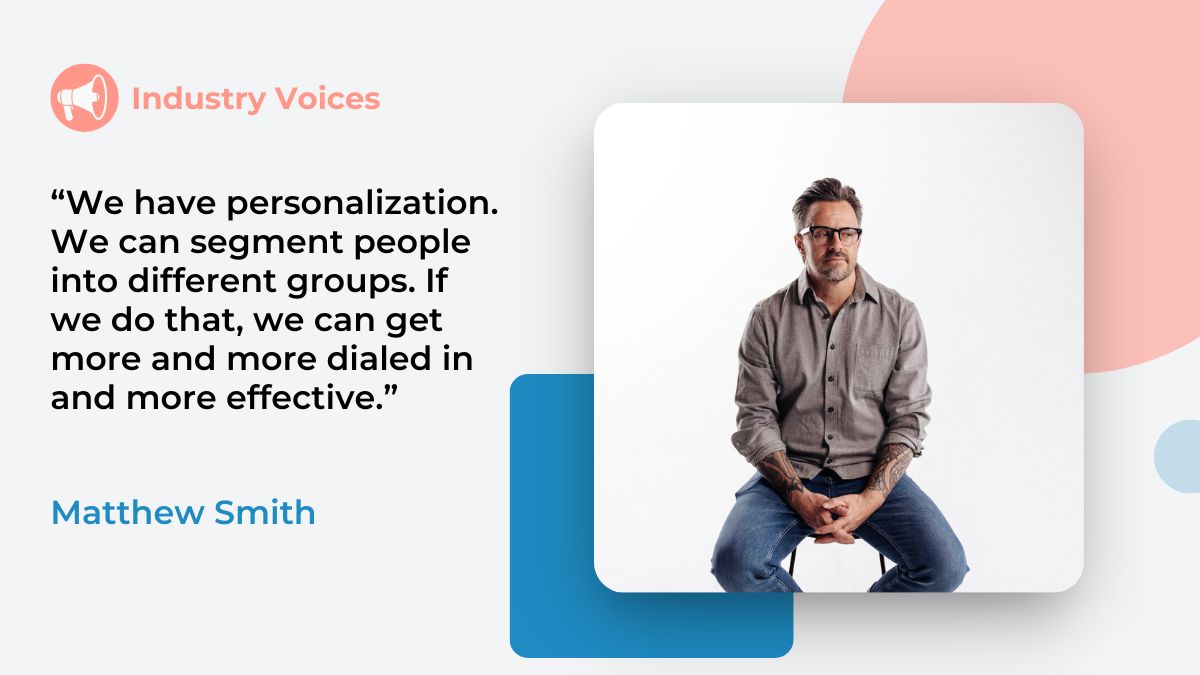
Then we have tooling that we can use to make that more relational. We have personalization; we can segment people into different groups. If we do that, segmenting with wisdom and care or through surveys or other things, then that can get more and more dialed in, more effective, more appropriate.
Here’s a good example: my friend Jorge was running an email campaign for Reverb, which sells used music tools, used instruments, things like that, and technology. They had one newsletter for a long time that would just go out to everybody, almost like the pamphlet you would get in your Sunday newspaper growing up. Here are all the ads for everything. We’re trying to throw the entire catalog of coupons out. You’ve seen what will stick. And what they did instead was they started this segment of people based on their buying behavior and searching behavior.
For instance, if I’m interested in drumming, they’re just starting to show me more drum-oriented things. Then the arena of things that are peripheral to drums, and then they might have a link: go see everything that’s on sale at the bottom of the email. But the emails themselves were much more segmented to specific audiences. They saw sales skyrocket from that. Why? Because you’re no longer touting everything to those individuals.
Now that’s not quite the same as me noticing my girlfriend doesn’t want to have a conversation right now, but it’s leaning in that direction. You’re just being more thoughtful, more appropriate.
Then you can take it further by either following up with the individual audience and learning more about them, learning what makes them tick. Or you can just get thoughtful and crafty and notice things about their buying behavior. Then, you can create triggers that connect to them as an individual.
Maybe you’re asking them questions, maybe you are sending them an offer. But I think the opportunity is to figure out ways to use automation so that you can scale a tool like this but also be thoughtful.
Another good example is for Mother’s Day or something like that, just asking people if they’d like to meet that. A lot of people have difficult mother-father experiences, right?
Or an example might be, during some of the Black Lives Matter stuff, we turned off some of our weekly emails. We sent a letter to everybody saying: “Hey, we’re really sad about this. And we stand with our BIPOC friends, and we really want to see justice and we want to see restoration and we believe in love.” That was a pause from our normal: here are all these goofy things that Really Good Email says. Instead, we were not tone-deaf. We were well-toned, right? We thought about that. That really connects with people. That’s relational.
So this is how I think about these things.
What’s interesting is we all know this stuff. If you get out of your marketing head and just get into relationship head, you ask: how would I treat my mother if she were my customer? Would I set different things? Probably. So, maybe start thinking about how you would send emails to a relative. What kind of information would you want them to know?
Related: Yuval Ackerman, The Ethical Email Strategist, on Common Email Challenges
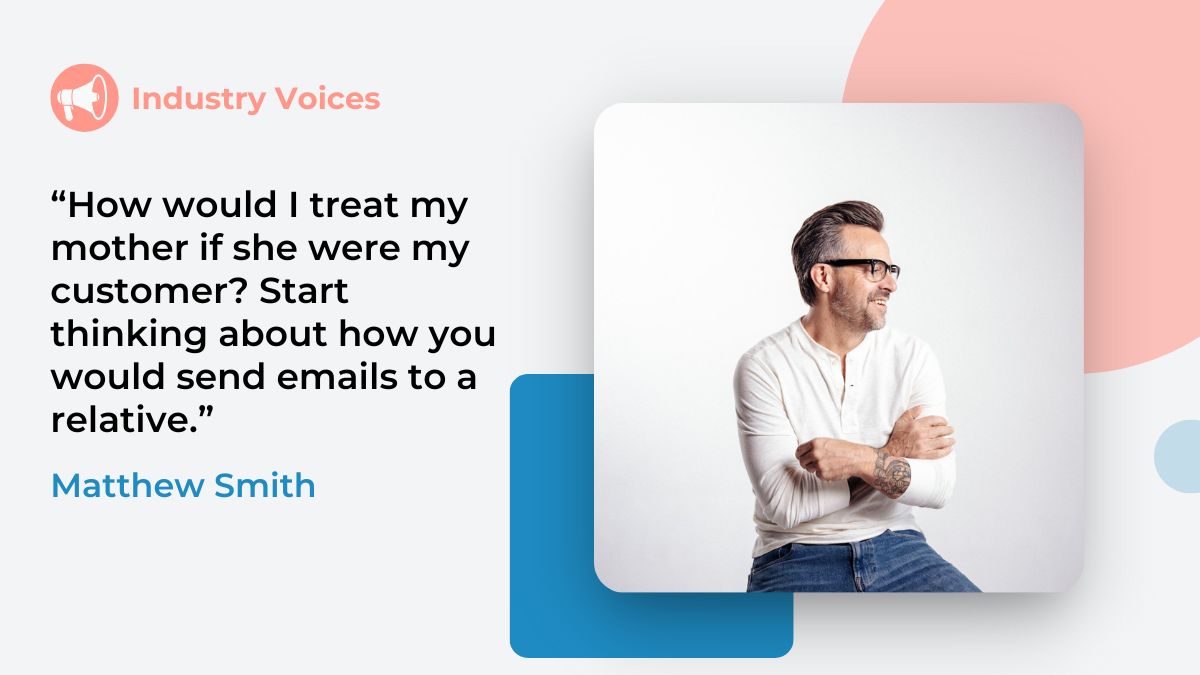
What are some other ways that people can have a better opportunity for click-through or engagement with their emails?
One of the key things is really looking at your brand and your design. My instinct is that most people try and do too much in their emails. So they say: “Okay, I’ve got to make my emails look good.”
If you have a small team, and you don’t have the capabilities to really know what you’re doing with design, find a really simple template and masterfully go after that. Maybe a black-and-white template with black-and-white imagery. Consider great iconography that’s black and white and is really simply done, with nice big text that just reads clearly. If your language is strong, that’s going to nail it all day long.
So this is where you hear people arguing for text-based emails. There’s a reason for that.
If your design is not enhancing and making it easier for a person to read your content, scan it and understand what to do, then it’s failing. Also, if your design is in any way too much and it’s actually weighing down your email, then your deliverability goes down.
So if it’s literally the amount of design elements – imagery, and other things – that make your HTML a large kilobyte size, then that’s going to detract people from being able to take action. And if what you’re designing, especially in that first part, sort of above the fold, is not creating intrigue, curiosity or a sense of trustworthiness to create a hook to drive people down into the rest of the email, then you’re failing.
There are known, well-established methodologies to improve that stuff. It just takes time to research it. Go use ChatGPT to learn more about it, whatever you need.
That’s one of the things I’ll say about the emails that we often reject at Really Good Emails.
I very rarely have seen an email that had too little that I rejected. It’s almost always too much.
And, usually, it’s the kind of thing where if somebody would just trim down and really focus, they’d find that “less is better” and it’s much more effective.

So less is more when it comes to design. But how do you know what to trim?
Figuring out what to trim is hard. So less is better is hard work. It was Hemingway or Wadsworth or one of these old writers that said, “I’m so sorry, I would have made this shorter, but I didn’t have the time.” Right? He was writing a letter to a friend or something like that. That really resonates with me.
The editing process is really challenging. The thing that I like to do is play design golf. I’m not actually a golfer, so it’s kind of a funny thing for me to use a sports metaphor. Basically, in every design, you have to ask yourself: “Is this little point of difference, this change, this different thing? Is it worth an extra point? Is it doing a job?”
You may have four or five types of typography, and that includes sizes and colors. So you might be using all Helvetica, but if you have a large heading and it’s black, bold, Helvetica, that’s one point. And then you have a body copy that’s 12 or 14-point, regular. That’s two points. If you have, then, a Georgia script or some other font, that’s three. If you have a line that moves across the page and divides something, that’s a point.
You add all these points up, and then you ask yourself, are all these points doing a job? So do I need that line there? Is that actually serving the need of the customer? Is this image adding a lot of value? If it’s not, remove it.
Trim down to the basic MVP, or MVE: Minimum Viable Email, and see what you need to add to really enhance it. Otherwise, text can do the job, right?
Related: ZeroBounce talks to Ari Meisel of Less Doing about productivity and reimagining inbox zero.
Has the reason behind Really Good Emails changed at all?
Probably, in some ways, no. In some ways, yes.
I started Really Good Emails because I had been a Creative Director or Chief Creative Officer on a couple of different startups and had noticed that I was always looking at: Where are the great welcome emails? Where are the great transactional emails? Where are the great receipts or e-commerce emails? And it was wading through a huge ocean.
It was almost ten years ago that I started Really Good Emails. There is so much more information out there, but it’s too much. We need curation. Back then, I knew that there wasn’t anything out there like that. And I knew that there was a little business opportunity that I could just spin up a WordPress site and get something going and get Mailchimp to sponsor it. That was great. It worked.
Then, fast forwarding, today we have our community.
Our newsletter is like 220,000 people now. It was so wild to hear that. But it’s grown so significantly over the last two years. What we’ve learned is that we’re now at the epicenter of helping people think through what is the best in class through email.
We’re still doing this on the side. Most people don’t know that. I run a full-time design agency. Really Good Emails is still a side project, and as a team, we take home $500 a month each. So that’s $6,000 a year to run Really Good Emails. It’s like a full product, and we’re talking about four people. We just keep putting money back into the product, and we’ve been trying to build an application and doing all these things.
The exciting thing is that we’ve just found ourselves to be in a privileged, special space where we can champion this community and help it become its fullest self.
When I started that, I just thought it was a service. Now, I can see that it’s got a huge opportunity to be the center of a community. That means more events, more opportunity to really celebrate everybody out there, to create resources. That’s where Really Good Emails is heading.
I know it means a lot to people, and I’ve heard firsthand from people who would say things like, “I got in! I’m in Really Good Emails this week. It’s me!” What’s a small change that email marketers could make that would result in a big change?
It’s a good question. I’m sort of leaning back to what I said before. Look for what you can cut out rather than add in and then really understand your core positioning. If you understand your customers well enough, your content will reflect that.
Related: What makes great content?
I’m trying to think of a good example, but the Reverb example is not a bad one again. It turns out that Matthew doesn’t want information about guitars. He wants information about drums, so let’s send him that.
Get to know the language that lands well with your customers.
Spend time with them.
Give them a gift card or something like that, to sit down for a 30-minute call and just ask them: “Hey, can we go through three emails? And you just tell me, how did these land for you? How did they feel? What did you think about them?”
Get that qualitative information and especially from five to seven different types of audiences. See what you can learn so that you can dial in your emails more effectively. That can all be done in a week. You could do five interviews, set them up, but just really start to understand your audience a lot better. Then try changing some language.
My designer friends would kill me for saying this, but again, great design should be an enhancement to the copy. The content is what this email is all about. It is not the design.
Now, if you’re a fashion brand, you’ve really got to show off your clothing.
For example, a shoe brand like Nike. Also, Everlane is a good example. They want to show off their materials. You couldn’t send a text email very effectively with Everlane. But other than photography, they need to work on their ability to communicate clearly and make sure that they’re addressing their audience in a meaningful way.
If Everlane suddenly started selling fancy watches, customers would say: “This doesn’t make any sense. This is not what this company is about. They’re about sustainability. It’s about core clothing materials, not the extra stuff. That’s why I like them.”
So you’ve got to understand your audience and then dial into the right content. Again, for me, it’s about trimming, not adding.
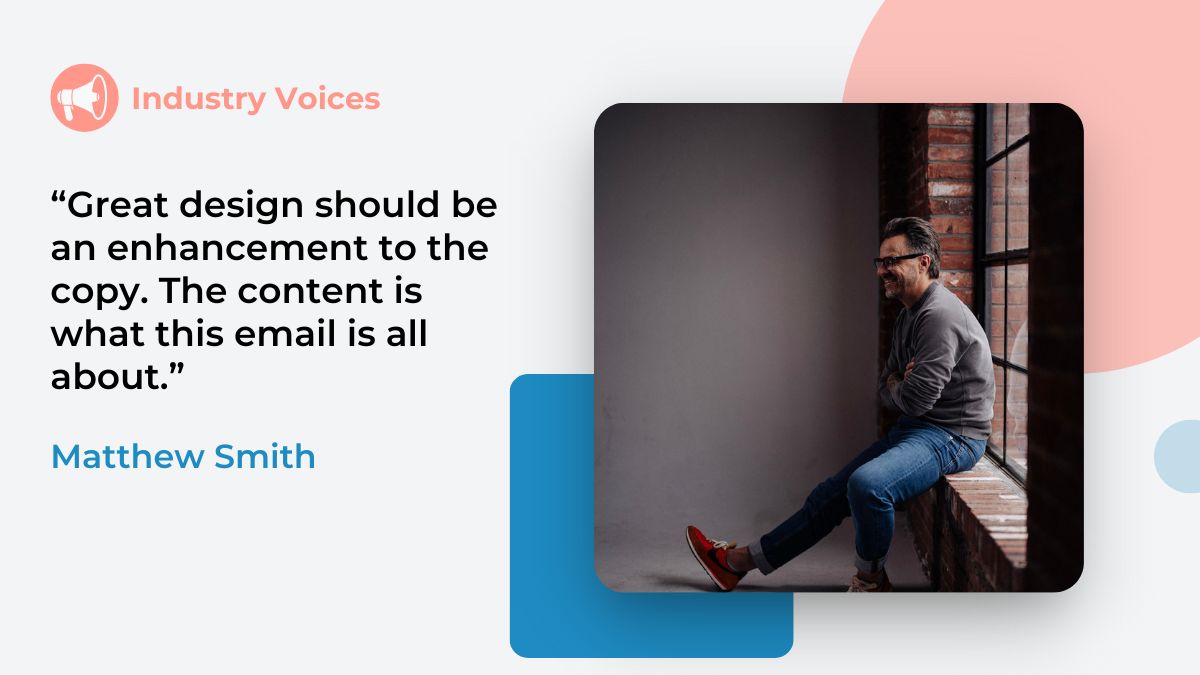
Could you recommend books for someone out there who wants to learn more about design to apply to email?
Absolutely. My recommendation would be to look into web typography. There are several books in the group called “A Book Apart.” Anything in their swath of reading is going to be fantastic. There’s my friend Aaron Walter who has written a book called Designing for Emotion. Within that “A Book Apart” series, he actually featured some of my work in that book. It’s a great book.
In addition, I love a book called Understanding Comics by Scott McCloud. It’s wonderful that he uses the comic book style as a way to teach visual language. It’s a fantastic foray into understanding the visual language better.
Then honestly, I think anybody that could take a design course, There are some great online courses these days so you can understand some of that material. Dive into YouTube, just to understand hierarchy and layout, etc. That’s going to be a huge benefit.
In terms of brand, anything by Marty Neumeier is interesting. Zag is one of those, and The Brand Gap is great. Those are fantastic. Then, in terms of content, I highly recommend my friend Clay Hebert. You can look him up on Twitter. He understands content very well and writes a lot about it.
You may try dialing in your understanding of A.I. and thinking about how to use A.I. in your writing as a drafting or sketching tool that you then edit on. You can make some huge improvements to your content just by leveraging some of that.
Before we go, what encouragement could you give to someone out there who is in this email space?
I would encourage them to know that they have much more agency and capability than they probably realize. They can go with their instincts to follow what they’ve learned. As they’re learning more, to work with their management teams and others. But drive toward relationships. If they drive toward their instincts in that space, they can often do really effective things. If they’re feeling overwhelmed, they’re trying to do too much.
One of the things I’ve learned as a sober person is: just do the next right thing. Take off that next small little piece and do that next thing well. And then, “Okay, Thank you.” You can Marie Kondo that and thank it. Send it.
Then you do the next right thing. Right? That methodology has served me well because it’s easy to get overwhelmed these days. There’s so much to learn, so much to do, so much to think about. But if you focus on that next right thing, it’s a good place to be.
Check out Really Good Emails online and be sure to subscribe to their newsletter!
Table of Contents
- Everybody in this community of email folks or email geeks is thinking about community in the face of AI. We know AI is coming at us. What do you think is coming?
- Have you always been interested in “community”?
- Email geeks definitely feel like a community, don’t you think?
- I do see people seeking out more connection and realness – a real human-to-human interaction. And there's a way to do that with email. I know we can.
- I want to go back to something I've heard you say a couple of times. That email is relationship. How did you come upon that realization?
- How can understanding relationship help those in email?
- What are some other ways that people can have a better opportunity for click-through or engagement with their emails?
- So less is more when it comes to design. But how do you know what to trim?
- Has the reason behind Really Good Emails changed at all?
- I know it means a lot to people, and I've heard firsthand from people who would say things like, “I got in! I'm in Really Good Emails this week. It's me!” What's a small change that email marketers could make that would result in a big change?
- Could you recommend books for someone out there who wants to learn more about design to apply to email?
- Before we go, what encouragement could you give to someone out there who is in this email space?






